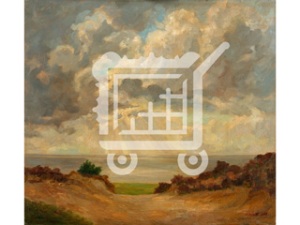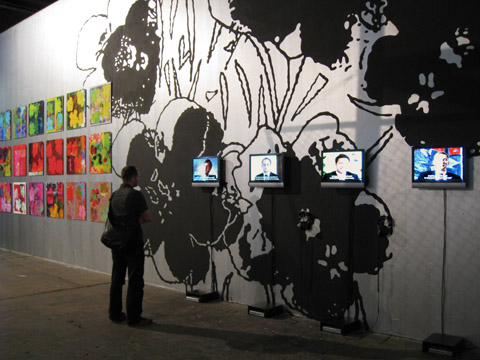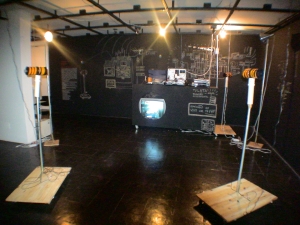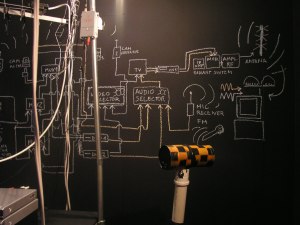Information visualization field is becoming more and more into the physical space. Sometimes as an everyday life practice and often in the form of an ambient object .
 We can observe projects in which data about casualties in Iraq is visualized through a tatoo made on a man’s back, that shows the relations between places, deaths and military operations; energy consumption data is undertaking collectively by illuminating the inside of the apartments in a community building with different light colors, and global warming awareness campaign in China, is realized by representing traffic CO2 emissions with a big black globe of “pollution” coming out from a real car’s pipe.
We can observe projects in which data about casualties in Iraq is visualized through a tatoo made on a man’s back, that shows the relations between places, deaths and military operations; energy consumption data is undertaking collectively by illuminating the inside of the apartments in a community building with different light colors, and global warming awareness campaign in China, is realized by representing traffic CO2 emissions with a big black globe of “pollution” coming out from a real car’s pipe.
In the design field, ambient devices can show data about energy consumption at home. This objects that are increasingly becoming part of our home furniture, work always as a useful and expensive “behavior adviser” in order to “save energy”. In parallel, wearable data devices are commonly used by people as a way to communicate their own information with other people or to inform others about, for instance, the environmental noise level. By wearing clothes, jewelry, etc.. data is visualized with commercial purposes by companies or with technological goals by labs. Anyway, performing information visualization can be a persuasive tool and can contribute to make people aware about different issues as Andrew Vande Moere explained in his last lecture at the SEE Conference last April (2010). Researchers, artists, activists and educators who work with software programs for turning numbers into images are also interested in making these images more effective and subsequently turn them into physical objects or performances. Persuasive visualization’s main goal is to make data visible and present.
It seems clear by following these examples, that the “performative turn” has become part of the Infovis field and that the ubiquitous computing world is integrated in new ways within the data information realm. Data showed in these ways is blurring the boundaries between disciplines (architecture, data art, Infovis, locative media, geography, etc) and interests (commercial and academic). In this context it is difficult to distinguish an efficient and proper information visualization project related to the performative field.
Dance, for example, has always been one the artistic disciplines that has made use of data movement information to recreate and suggest new ways in which audience can perceive and experience movement, through bodies and in the space around us [1] .The goal is not exactly the same that the examples above. In dance, the visualization of the performance has always been related to the realm of human computer interaction in oder to create closeness between dancers and audience. Gideon Obarzanek has worked on this kind of visualizations with interactive software and dancing movement. Based on aesthetic and kinesthetic stimulus, his work with the Chunky Move dance company, has created visualizations distributed into different layers of images and movement that “we cannot normally see but which we feel or know to exist”. It can be perceived as an aesthetic way to understand better the dancer’s movement and appreciate much more the movement generated. It is a sensitive way to complement the dance with visualizations that in several ways works as a feedback tool.
However, what about the other way around? How can we understand the movements of a dancing performance not focus on an aesthetic experience but on the movements and rules that make a choreography of movement?. We cannot perceive every movement in the space in a choreographic performance. But can we understand the process of a choreography? Is it possible for us to understand dance in a scientific way?. How can Infovis help us to understand relational movement in space?
I propose in the following brief overview, to explore the connections between choreography of movements and information visualization within an educational research context, through a project that visualizes choreographic information in new ways, Synchronous Objects. 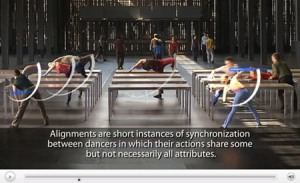 This project is seeking to make dance accessible through visual communication techniques. It flows from dance, to data, to objects. Through visualizations in forms of information graphics, 2D and 3D animations and visual dance scores, an interdisciplinary team (choreographer William Forsythe, Ohio State University’s Advanced Computing Center for the Arts and Design (ACCAD) and the Department of Dance, Synchronous Objects) has develop a set of data visualization tools that can capture, analyze and present the choreographic structures and components of Forsythe’s “One Flat Thing, reproduced” (OFTr), which premiered in 2000. After 3-year collaboration, the project has involved a group of over 30 artists, dancers, designers and scientists who explain here their interdisciplinary research.
This project is seeking to make dance accessible through visual communication techniques. It flows from dance, to data, to objects. Through visualizations in forms of information graphics, 2D and 3D animations and visual dance scores, an interdisciplinary team (choreographer William Forsythe, Ohio State University’s Advanced Computing Center for the Arts and Design (ACCAD) and the Department of Dance, Synchronous Objects) has develop a set of data visualization tools that can capture, analyze and present the choreographic structures and components of Forsythe’s “One Flat Thing, reproduced” (OFTr), which premiered in 2000. After 3-year collaboration, the project has involved a group of over 30 artists, dancers, designers and scientists who explain here their interdisciplinary research.
The dance piece is based on the idea of expressing and transforming the choreographic ideas behind William Forsythe’s dance [2] explained through 20 visual objects, over 40 movies and 5 generative tools. The interesting thing is that the academic aim of this project is to make understandable dance and movement by using visualizations techniques; movement densities, annotations, generative tools and algorithms are used with this purpose. Forsythe says about the collaboration that his approach is to put into question things like: “What else might this dance look like?” and “What else, besides the body, might physical thinking look like?. Specifically, the project wants to explain how the Forsythe’s “counterpoint” concept is performed by dancers. Movement material, cueing and alignment are the three systems that interact in form of themes (understood as dancing movements). There are 25 themes which are recombined over the dance and also improvise movements that dancer can do “by translating specific properties of other’s performer’s motion into their own”.
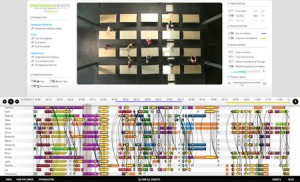 Their data includes Spatial Data, tracking a single point of each dancer in three-dimensional space, and Attribute Data, “built from the dancers’ first hand accounts, such as when the gave or received a cue, what alignments they followed, when they were improvising and what themes they were performing in every second of the dance”. Forsythe’s dance is very related to time. To him, “bodies in dance are time machines, time is the exquisite product of dancing body” [3]. Erin Manning writes; “In Forsythe’s work, time-machines often stand-in as propositions for generating movement. Using both quantitative methods (clocks, watches, metronomes) and qualitative devices (varying the volume and melody of a voice while counting, altering the duration and rhythms of the counts), Forsythe plays with the double time of movement”. [4]
Their data includes Spatial Data, tracking a single point of each dancer in three-dimensional space, and Attribute Data, “built from the dancers’ first hand accounts, such as when the gave or received a cue, what alignments they followed, when they were improvising and what themes they were performing in every second of the dance”. Forsythe’s dance is very related to time. To him, “bodies in dance are time machines, time is the exquisite product of dancing body” [3]. Erin Manning writes; “In Forsythe’s work, time-machines often stand-in as propositions for generating movement. Using both quantitative methods (clocks, watches, metronomes) and qualitative devices (varying the volume and melody of a voice while counting, altering the duration and rhythms of the counts), Forsythe plays with the double time of movement”. [4]
To Forsythe, choreography and dancing are two very different practices; “in the case that choreography and dance coincide, choreography often serves as a channel for the desire to dance. One could easily assume that the substance of choreographic thought resided exclusively in the body. But is it possible for choreography to generate autonomous expressions of its principles, a choreographic object, without the body?”.[5].
The intersection of this project in the new media field is that the use of media technologies does not look for the common purpose of complementing the artistic performance or tracking the dancer’s body movements. Instead, dance as artistic experience is relegated and the concept of choreography is highlighted to get further insights. their purpose is to reflect the challenge of “making dance knowledge explicit and sharing it not only on stage and in the studio (as we are accustomed) but also through media objects”[6]. This is perfectly reflected on the project team’s comments at their website, where it can be understood, that in this case, is not the art field that uses visualization techniques to improve their performance, but the dancing performance itself is deconstructed through visualization techniques to offer users, a better understanding of the movement executed. Thus, users are everybody who “doesn’t understand dance” and want to play with synchronous objects data. The project offers a fruitful understanding about what information visualization and art, as an interdisciplinary research is about.
[1] Manning, Erin Prosthetics Making Sense: Dancing the Technogenetic Body. Fibreculture Journal Issue 9. 2006 http://journal.fibreculture.org/issue9/issue9_manning.html
[2] Forsythe’s choreography is grounded in a deconstructive reconsideration of the possibilities of classical ballet structures and theatricality, innovative applications of improvisation which he and his ensemble have developed and refined in over two decades of sustained dance research, and an increasingly collaborative approach to producing choreography. Forsythe works engage deeply with performative conventions and the fields of contemporary visual arts, architecture, and interactive multimedia. In 1994, Forsythe authored a pioneering and award-winning computer application Improvisation Technologies: A Tool for the Analytical Dance Eye which is used by professional companies, dance conservatories, universities, postgraduate architecture programs and secondary schools.
[3] Forsythe, William. Suspense, ed. Markus Weisbeck (Zurich: Ursula Blickle Foundation, 2008).
[4] Manning, Erin. Propositions for the Verge. William Forsythe’s Choreographic Objects Inflexions magazine, January 09.
[5] Forsythe, William. Choreographic Objects, 2009 at http://www.wexarts.org/ex/forsythe/
[6] Zuniga, Norah at http://mediacommons.futureofthebook.org/imr/2010/04/28/synchronous-objects-what-else-besides-body-might-physical-thinking-look
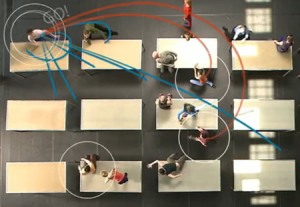
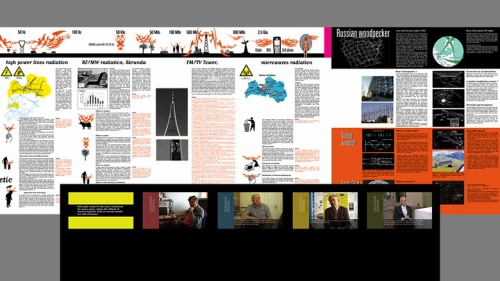

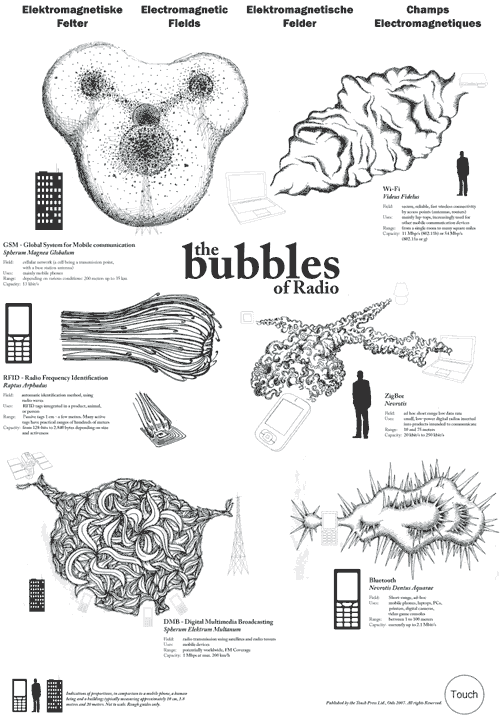
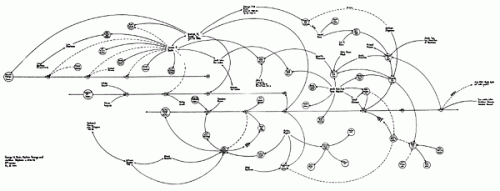
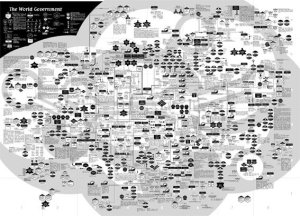
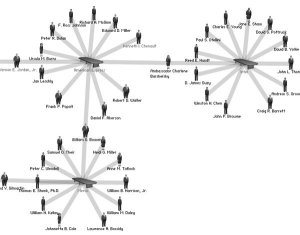

 The main idea of the “Long Tail” concept breaks the traditional 80-20 rule, also known as
The main idea of the “Long Tail” concept breaks the traditional 80-20 rule, also known as 